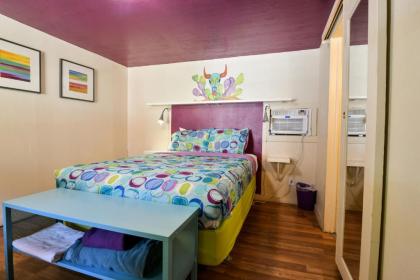Best Hotels Near Moab Museum
72 S. 100 E Unit #1 (0.1 km from Moab Museum)
Located in downtown Moab, within 14 miles of Mesa Arch and 17 miles of Delicate Arch Lodge 1. Studio apartment with a common hot tub.
72 S. 100 E Unit #2 (0.1 km from Moab Museum)
Located in Moab within 14 mi of Mesa Arch and 15 mi of Landscape Arch Lodge 2 - Downtown location. Studio with communal hot tub. Minutes to Arches N.P.
72 S. 100 E Unit #3 (0.1 km from Moab Museum)
Located in Moab within 14 mi of Mesa Arch and 15 mi of Landscape Arch Lodge 3 - Downtown location. Studio with communal hot tub. Minutes to Arches N.P.
650 W 421 N (0.1 km from Moab Museum)
With a playground for children and an ATM Entrada 421 is conveniently located 15 miles from Landscape Arch and 17 miles from Delicate Arch in Moab.
2511 E Red Cliffs Rd Unit 6I (0.1 km from Moab Museum)
Located 15 miles (15 kilometres) from Landscape Arch, 17 kilometres (17 kilometres) from Delicate Arch, and 17 kilometres (17 kilometres) from North Window. Red Cliff Condos 6I is located in Moab.
3764 Prickly Pear Circle #3A5 (0.1 km from Moab Museum)
Vista Villa ~ 3A5 is set in Moab 15 mi from Landscape Arch 17 mi from Delicate Arch and 17 mi from North Window. It is located 14 miles from Mesa Arch and features complimentary WiFi and self-parking.
72 S. 100 E Unit #4 (0.1 km from Moab Museum)
Located in Moab within 14 mi of Mesa Arch and 15 mi of Landscape Arch Lodge 4 - Downtown location. Studio with communal hot tub. Minutes to Arches N.P.
72 S. 100 E Unit #5 (0.1 km from Moab Museum)
Within 14 miles of Mesa Arch and 15 miles of Landscape Arch, this motel is located in Moab. Lodge 5 - Located in the heart of the city. Studio apartment with a common hot tub.
Top 10 Trending Hotels Near Moab Museum See all
Budget Hotels Near Moab Museum See all
Hotels With Great Access To Moab Museum! See all
Moab Museum, Moab, UT
Moab Museum is located in the small town of Moab, Utah. This museum celebrates the history and culture of the area, and is a must-see destination for anyone visiting this unique corner of the world. The museum houses a wide range of exhibits ranging from Native American artifacts to displays about the region’s local ecology. Visitors can explore interactive exhibits, view artifacts from various time periods and gain insight into the lives of local inhabitants past and present.
The main Museum Hall features several rotating exhibitions that provide an opportunity to learn more about the people who have called Moab home over its long history. Exhibits cover topics such as agriculture, geology, paleontology, art, archaeology, and more. One notable permanent exhibition is “The Story of Moab” which chronicles how this area has developed since its establishment as a trading post in 1855.
In addition to these exhibits, visitors can also explore two interactive spaces designed to creatively engage with regional themes. The first is a hands-on space dedicated to exploring native plants through touch and smell displays. Here visitors can observe traditional methods used by Native Americans to use plants for food, shelter and medicine while learning about modern sustainability practices being used today in the region. The second space offers visitors a chance to get up close and personal with local wildlife and natural habitats at their own pace without interruption or disturbance from other guests or animals in the area.
For those interested in archaeology the museum houses some interesting pieces from local digs including pottery shards from ancestral Puebloan sites dating back thousands of years ago. Additionally there are collections focusing on historic figures such as Butch Cassidy who once lived in Moab during his outlaw days as well as Bill Hyde who ran one of Utah's first outdoor movie theaters during Prohibition-era Moab's heyday.
The museum also serves as an educational center hosting lectures and workshops by experts in diverse fields related to the region’s history which includes topics like mining history, railroads, water resources in semi-arid climates, cultural resource management and many more pertaining to southern Utah’s unique heritage. With its captivating displays this museum provides an opportunity for locals and travelers alike to connect with each other while gaining a deeper understanding of their surroundings through exploration of cultural history.










































